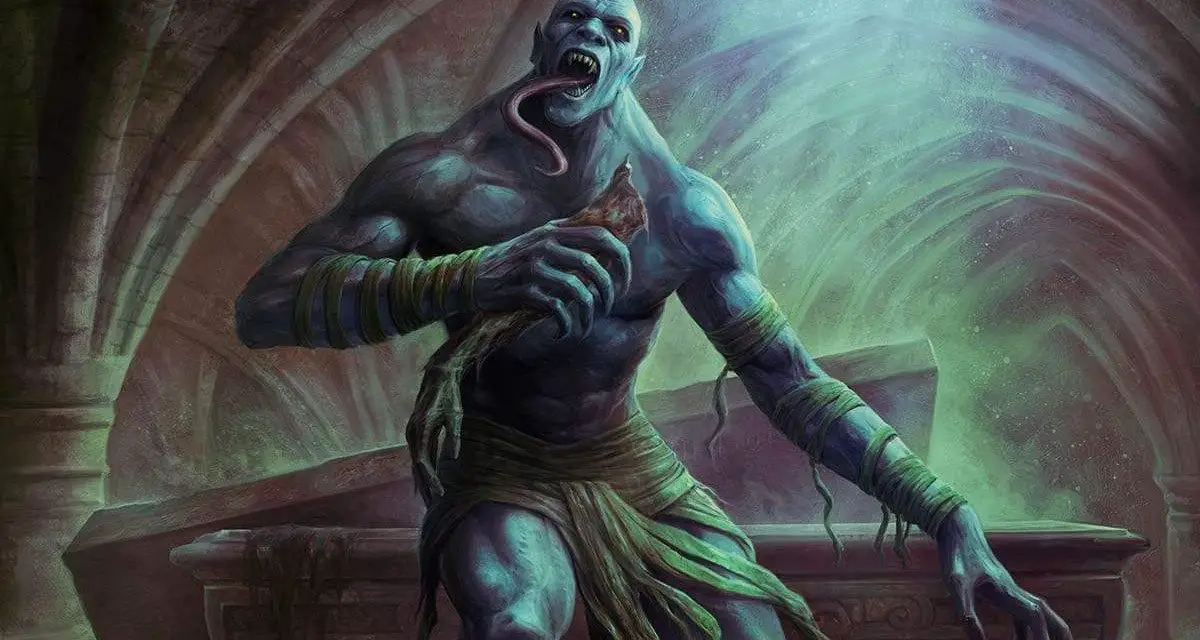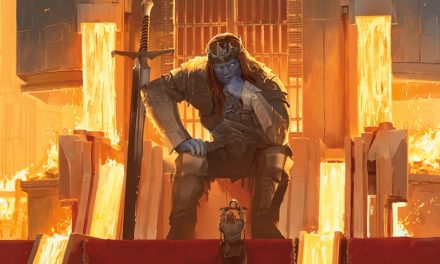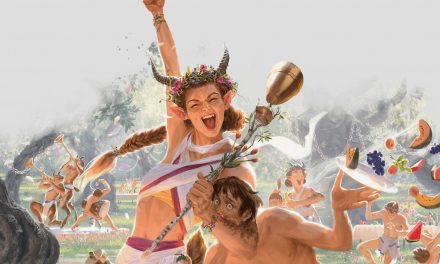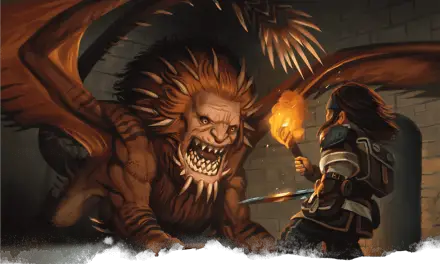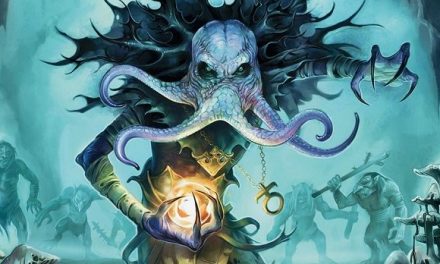It should go without saying, but many creatures in D&D would love to eat your party. At the top of that list would be the debaucherous flesh-eating Ghoul and its more powerful cousin, the Ghast.
It should also go without saying it’s also best to avoid graveyards and recent battlefields after sundown. For this is the realm of the ghoul, or rather ghouls (plural) who roam in packs looking for their next meal.
These savage and chaotic evil undead abominations are a staple of Dungeons and Dragons. You’ll find them in every edition of D&D, and for good reason! They’re worthy foes with one simple motivation: to make you their next meal.
Keep your torch lit, your weapon drawn, and your holy symbol on you!
This is our guide to Ghouls and Ghasts in D&D 5e!
What are Ghouls in D&D 5e?
Both the Ghoul and the Ghast are your classic flesh-eating undead nightmares that hunt in packs.
Their origins are usually demonic as they are created by abyssal energy. However, spells such as create undead can also produce ghouls.
Regardless, legends claim that Ghouls were debauched flesh-eating cretins before they became undead, whether created through abyssal energy or necromancy. They were tainted in life and “rewarded” with undeath as a result.
Ghouls are chaotic evil and “live” to feast on humanoid flesh, they serve no one but themselves. Unlike similar lower-level undead, the Ghoul isn’t a mindless servant of a necromancer. They have just enough intelligence to fully know what horrible things they’re doing… and love it…
Ghouls and Ghasts also possess some self-preservation instincts and tactics unlike other undead like skeletons and zombies.
They have been known to drag off paralyzed prey instead of continuing to fight unless their prey is easy pickings. Ghouls have mastered ambushing and hit-and-run tactics that oftentimes leave adventuring parties in tatters.
Ghouls are the ultimate cannibalistic evil undead monsters that give players nightmares and for very good reasons.
Both the Ghoul and Ghast can be found in the 5e Monster Manual.
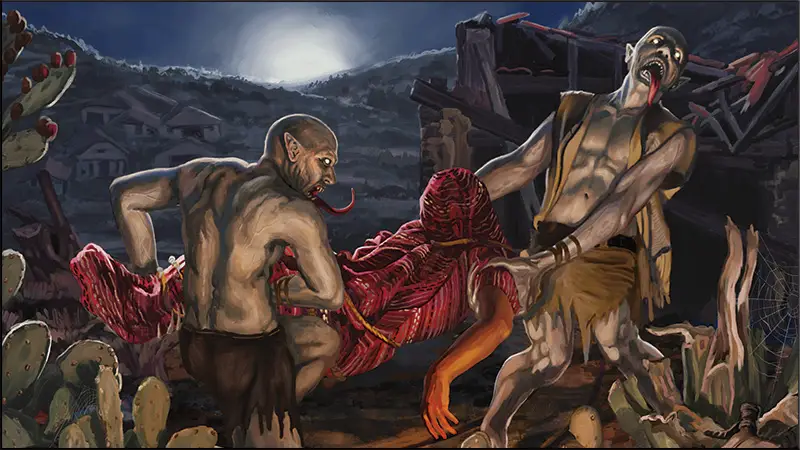
Appearance
Ghouls are medium-sized undead creatures.
As you might expect, they’re… disturbing, to say the least… With grey skin stretched tight over their body, they resemble emaciated corpses.
One interesting note is that Ghouls’ flesh does not rot, something that I think is actually new in 5e D&D. That means that a pack of Ghouls could potentially be waiting in a dungeon or other location for years, decades, or even longer!
They have red eyes that glow like coals as well as jagged claws and discolored, razor-sharp teeth.
Ghouls and Ghasts tend to wear the tattered remains of the clothes they wore in life or nothing at all. After all, they have no one to impress.
A ghoul or ghast oftentimes resembles the person they were in the realm of the living, though any trace of humanity is long gone.
Because of their diet and the lairs that they dwell in, Ghouls also reek of decay and rot. This stench is even more pungent with Ghasts and can easily overwhelm the senses of most of their potential victims.
You Might Like: 10 Terrifying Monsters For Your Halloween D&D Game
Ghoul Abilities
At first glance, the Ghoul in 5e seems a bit underwhelming, even for a low-level group of adventurers. This might be true for the rare encounter with a solitary ghoul or ghast…
However, Ghouls tend to hunt in packs and some packs are led by a Ghast. A pack of ravenous Ghouls is enough to both challenge and raise the tension level for even mid-level parties.
For low-level parties, they are an absolute nightmare and can easily lead to PC death. They should also be used with caution against low-level parties lest you end up with a TPK.
Ghouls and Ghasts are a mainstay in many low-level and mid-level campaigns for this very reason. Pack-based, flesh-eating undead creatures are perfect for almost any D&D campaign.
Ghouls have above-average Strength and Dexterity scores and they aren’t very intelligent. They’re basically melee-based savages who want to eat you.
Nom nom…
The higher Dexterity scores help with stealth and initiative, which can oftentimes wreak havoc on a party’s tactics. Ghouls are quick and frenzied and gone before you know it if you are not careful.
A Ghoul attacks with its razor-sharp teeth and jagged claws in combat. While its bite attack deals more damage it hits less often.
Bite. Melee Weapon Attack: +2 to hit, reach 5 ft., one creature. Hit: 9 (2d6 + 2) piercing damage.
Its claw attacks can paralyze an adventurer and are more likely to hit an adventurer.
Claws. Melee Weapon Attack: +4 to hit, reach 5 ft., one target. Hit: 7 (2d4 + 2) slashing damage.
If the target is a creature other than an elf or undead, it must succeed on a DC 10 Constitution saving throw or be paralyzed for 1 minute. The target can repeat the saving throw at the end of each of its turns, ending the effect on itself on a success.
Ghouls are infamous for their ability to overwhelm and paralyze their prey. However, some say the paralysis ability has been somewhat nerfed in 5e as it only requires a DC 10 Constitution saving throw. It also has no effect on Elven PCs. When a PC does fail their saving throw, however, it can be quite deadly.
As far as defenses go, ghouls are relatively easy to hit as they have low armor class but they can still soak up some damage, so don’t underestimate them!
Also, keep in mind that Ghouls can’t be charmed, they are unaffected by the exhaustion condition, they can’t be poisoned, and they are immune to poison damage.
Both Ghouls and Ghasts have darkvision up to 60 feet but do have lower-than-average perception.
Most ghouls speak Common as well as any languages they knew in life. Though I can’t imagine you’d have much of an enlightening conversation with one…
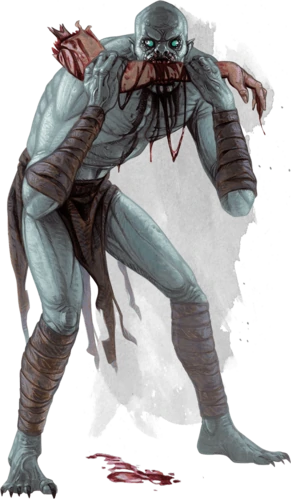
Debaucherous Devourers Of Flesh
Ghouls are driven almost entirely by their insatiable hunger. Not only do they hunger for carrion, but they specifically have a hunger for decomposing humanoid flesh as well as living flesh.
When Ghouls and Ghasts cannot find some rotting corpses to chow down on, they turn to hunting the living that wander too far into the countryside and near their putrid lairs. After all, what’s living can be made dead and what’s dead is dinner to a ghoul.
Ironically, neither Ghouls nor Ghasts need to eat due to their undead nature. They’re simply debauched monstrosities that revel in the consumption of humanoid flesh.
Ghoulish Origins
These foul flesh-eating nightmares can trace their roots back to the Abyss itself. Ghouls were created by the infamous granddaddy of undeath himself, the Demon Lord Orcus.
(Yeah, the very same Orcus that gave us other nightmare fuel like the Bodak, which you can read about here!)
Orcus infused his creation with abyssal energy which led to the ghoul’s paralytic melee attack.
Surprisingly, as the legend goes, the first ghoul was actually an elf who feasted on his own kind. This elf, Doresain, was a worshipper of Orcus who was “rewarded” by his dark lord for his service.
With some of the most powerful and evil magic imaginable, Orcus transformed Doresain into the first abyssal ghoul.
Becoming a ghoul pleased Doresain very much and he served his Lord with passion and loyalty to show his reverence and appreciation. With a disturbing glee, Doresain set to work transforming other followers of Orcus into ghouls.
Ultimately, however, Orcus betrayed his loyal servant. As another Demon Lord, Yeenoghu, and his army of gnolls threatened Doresain, Orcus refused to offer his servant any aid.
In desperation, Doresain was forced to repent to the Elven deities. Fortunately for him, these deities took pity on the foul undead creature and offered him salvation.
The elven deities blessed all elves at this point. Even to this day, this blessing is why elves cannot be paralyzed by a Ghoul’s claw attack.
However, an elf is not immune to a Ghast’s paralyzing ability.
Which reminds me…
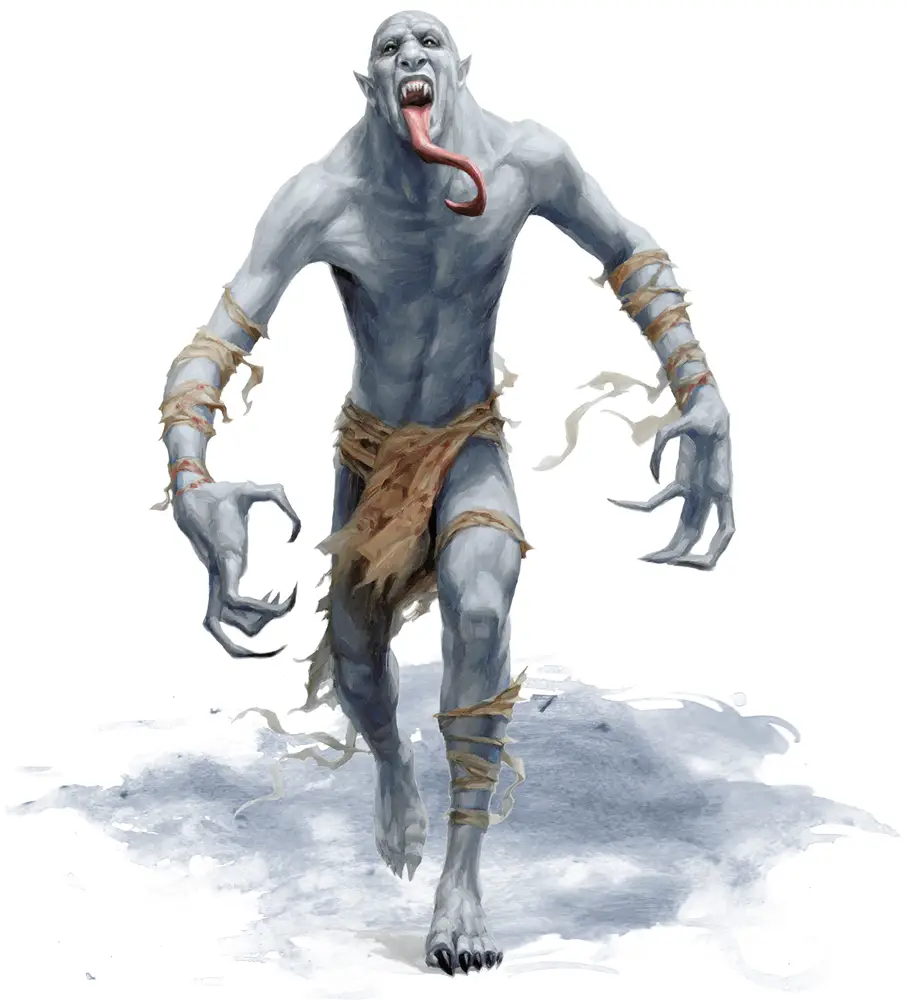
Ghoul Variant: Ghasts
Ghasts are said to be infused with more abyssal energy than the ghoul. The foul ghast is more physically powerful, dexterous, and intelligent than your average ghoul. It’s not incorrect to think of them as Greater Ghouls, if you will.
A pack of ghouls is terrifying enough, but a pack led by a ghast quite literally STINKS for your party of adventurers!
The ghast’s Stench ability poisons all within 5 feet who fail a DC 10 Constitution saving throw.
Stench. Any creature that starts its turn within 5 feet of the ghast must succeed on a DC 10 Constitution saving throw or be poisoned until the start of its next turn. On a successful saving throw, the creature is immune to the ghast’s Stench for 24 hours.
But that’s not all, a ghast greatly buffs a pack of ghouls against being turned. The ghast’s Turning Defiance ability grants itself plus any ghoul within 30 feet advantage on saving throws against turn undead effects.
It’s pretty scary stuff, so you’ll want to make sure that your Cleric is praying EXTRA hard if there’s a Ghast on the field…
Turning Defiance. The ghast and any ghouls within 30 feet of it have advantage on saving throws against effects that turn undead.
Ghasts have the same Damage Immunities and Condition Immunities as ghouls but they have resistance to necrotic damage unlike the ghoul.
Related: Running Horror Games in D&D 5e
Encountering Ghouls and Ghasts
As I mentioned, encountering a lone ghoul is rare. Ghouls roam in packs and can be quite deadly for low-level characters, especially for a CR1 undead.
Whether you’re a DM or a player, there are certain things that you can expect from an encounter with Ghouls and Ghasts.
So let’s look at encounters with these foul creatures from both sides of the DM screen!
Running Ghouls and Ghasts for Dungeon Masters
If you want to join Ghoul Club, there are some basic rules that you’ll want to know.
The first rule of Ghoul Club is ghouls are pack-based undead creatures. They enjoy hit-and-run ambushes over direct combat and prefer overwhelming single adversaries they can escape with.
While they aren’t going to be acing any algebra exams, they’re still intelligent enough to use some tactics while taking their prey by surprise, especially if they’ve got a Ghast to call the shots!
Speaking of which…
The second rule of Ghoul Club is to let ghasts join the club.
Having a Ghast in the encounter powers up a pack of ghouls perfectly. Not only are the Ghouls going to be harder to turn, but you can also use this as a reason to have them playing more tactically instead of just dogpiling on the first party member they see.
The third and last rule of Ghoul Club is to use packs of Ghasts to scale challenges for PCs into the mid-levels and beyond.
Ghouls aren’t limited to just one Ghast in their pack. It’s perfectly reasonable to expect 1 Ghast for every 4-5 Ghouls, though you might even have one Ghast for every 3 Ghouls if you really want to turn up the heat… and the stench…
Keeping these three rules in mind, Ghouls and Ghasts work best when used to overwhelm one target at a time. The paralytic claws as well as the Ghast’s Stench ability can quickly immobilize and overwhelm PCs.
Mixing in a Ghast forces a party to adjust. This is a good thing for your game since it adds tension and higher stakes and challenges the players.
Related: How to Keep Combat Engaging
The ghast’s Turning Defiance also increases the challenge and tension level in your game. Suddenly the party’s cleric can’t just instantly turn the tides, which can really terrify a party that has never encountered Ghouls led by a Ghast.
As for individual tactics, both Ghouls and Ghasts should use their claw attack on foes. If they’re able to tell that a character is an elf, it’s safe to reason that these creatures will prioritize those that they know might be more susceptible to their paralyzing claws.
Once a character is paralyzed, Ghouls and Ghasts should switch to their bite attacks to go in for the kill. Keep in mind that a paralyzed character is attacked with advantage and any hit from within 5 feet is a critical hit.
Ghouls are mindless hunger-driven chaos machines, however, a Ghast would know to prioritize characters with average or lower Constitution scores and who aren’t elven.
Keep in mind Ghouls are not so mindless that they wouldn’t have some sort of self-preservation. If things are looking bad, they have no problem running away only to try to ambush the party again later…
Another interesting tactic is to have Ghouls dragging off downed prey so they can dine in peace. As mentioned previously, Ghouls aren’t known for their intelligence but they do have some cunning.
Use ghouls with caution against low-level parties as things can get out of hand very quickly and lead to a TPK if the encounter is not balanced!
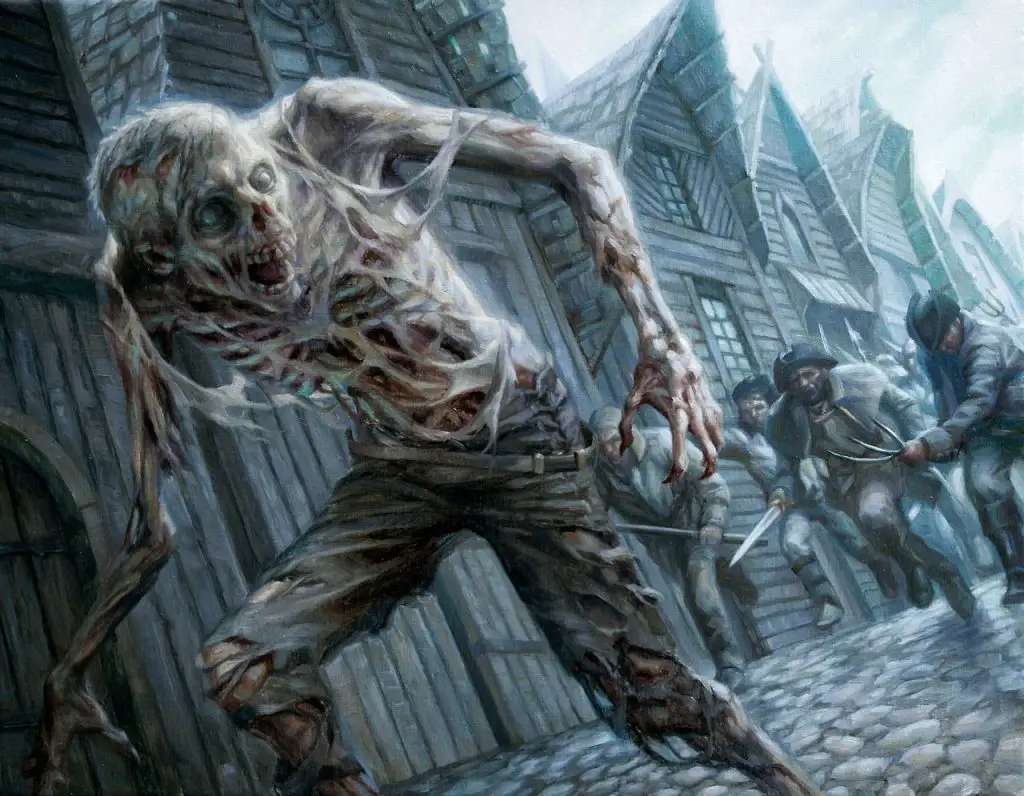
Fighting Ghouls and Ghasts as a Player
Breaking down the strengths and weaknesses of the Ghoul and Ghast is relatively simple.
For many players, when they hear the word “Ghoul” they immediately think of their much-maligned paralyzing claw attacks. Fair enough and it’s definitely a strength for these enemies that any adventurer should be wary of!
As I mentioned, a paralyzed character is attacked at advantage and all hits are critical hits.
This is very bad for your character, obviously. Failing one saving throw against one Ghoul’s claw means that the rest will be quickly moving in to dogpile. It’s brutal and as absolutely terrifying as it sounds!
Meanwhile, the Ghast’s biggest strengths would include their stench ability as well as their paralytic claw attacks.
Though perhaps the greatest asset of the ghast is its turning defiance ability. Clerics or Oath of Devotion Paladins will have a much harder time chasing these hungry undead off!
Ghasts have above-average Strength scores as well as Dexterity which helps with stealthy ambushes and higher-than-average initiative modifiers.
Their weaknesses are low armor classes and their uncontrollable hunger.
Ranged combat and Elves can also be seen as weaknesses for Ghouls and Ghasts alike who will have difficulty moving in close. If the character is an Elf, the Ghouls will quickly find that their typical tactic of “claw, paralyze, nom” isn’t as effective as they might have expected.
Keeping the pack of ghouls at a distance neutralizes their most effective offense as well as all of their attacks as they are melee based.
The key here, of course, would be initiative. Ghouls have a reasonably high Dexterity score which means some of the pack will inevitably be acting at the top of the round. If you can beat the ghouls to the punch, ranged combat is best though that’s admittedly a big “if.”
Luckily, starting at lower levels there are many AOE spells that damage and/or control or impede packs of ghouls. Standouts include classics like Shatter and Entangle to name just two examples.
You also should not forget Clerics and their Turn Undead ability. Ghouls that are turned are easily negated and can oftentimes be avoided. Though you might want to focus your attention to dealing with any Ghasts before you use that feature.
Another line of defense against ghouls are abilities and spells that buff a party.
For example, Resistance is a useful cantrip that will improve an adventurer’s Constitution saving throw starting at level 1. A Cleric’s Bless spell could also be effective as could the Bard’s Bardic Inspiration.
Also, you should leverage your Inspiration if you can. Failing a Constitution save is often the difference between life and death for novice and even more experienced characters alike!
It’s important that the party sticks close together and protects those with lower Constitution scores. This should help ensure no one gets singled out, dragged off, and had for dinner.
If you encounter ghouls being led by a Ghast or Ghasts, this will change things quite a bit. You’ll want to resort to a new set of tactics that should involve neutralizing the ghasts as soon as possible.
Given the Ghasts’ double-whammy of Stench and their paralysis, it’s best to keep your distance and hit as hard and fast as you can.
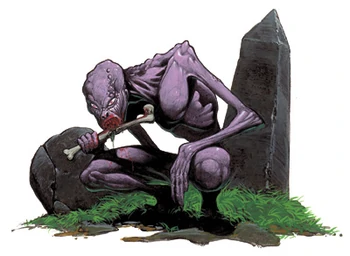
Conclusion – Ghouls and Ghasts in D&D 5e
The Ghoul and Ghast are classic D&D undead terrors, originally based on Arabic legends and then channeled through H.P. Lovecraft. Finally, being tweaked by Gary Gygax for his new fantasy game.
Given the number of undead creatures found in D&D 5e, it’s nice to see the Ghoul and Ghast as fan favorites still to this day.
Whether you’re a DM or a player, Ghouls can spice up almost any campaign. Because every D&D campaign needs packs of crazed flesh-eating undead that aren’t slow-moving mindless zombies, right?!
For DMs, these CR1 and CR2 creatures can easily be scaled up to give them more playability over the long term. Heck, the right pack of ghasts still challenges my players and they’re 8th level. If they’re played correctly, even your most seasoned players will start to avoid graveyards and crypts at night.
It should also be noted that Ghouls and Ghasts are easy to insert into a campaign. Any location with plenty of carrion or the dead is a ghoul’s paradise.
However, if I am going to be honest (and I will be), it seems the 5e Ghoul has been stripped down a bit relative to older editions.
Gone are their ability to inflict “Ghoul Fever” as well as their ability to create spawn. Honestly, it’s quite a downer and takes some of the body horror element away from these classic undead foes.
However, nothing stops you from homebrewing features like this into your own game!
Overall, I find the Ghoul and Ghast to still be very useful to any campaign style although they truly shine in a horror-based campaign.
Have you had a memorable encounter involving ghouls or ghasts in your D&D games? What are your thoughts on Ghouls and Ghasts in D&D 5e? Let’s chat in the comments!
Don’t forget to sign up for the Tabletop Joab newsletter! It’s the best way to get all the latest player guides, DM Tips, news, reviews, and more for D&D 5e right to your inbox!
You can also follow me on Facebook and Twitter.
If you found this article helpful and want to support the site, you can buy me a coffee here! (It’s not expected, but very appreciated!)

